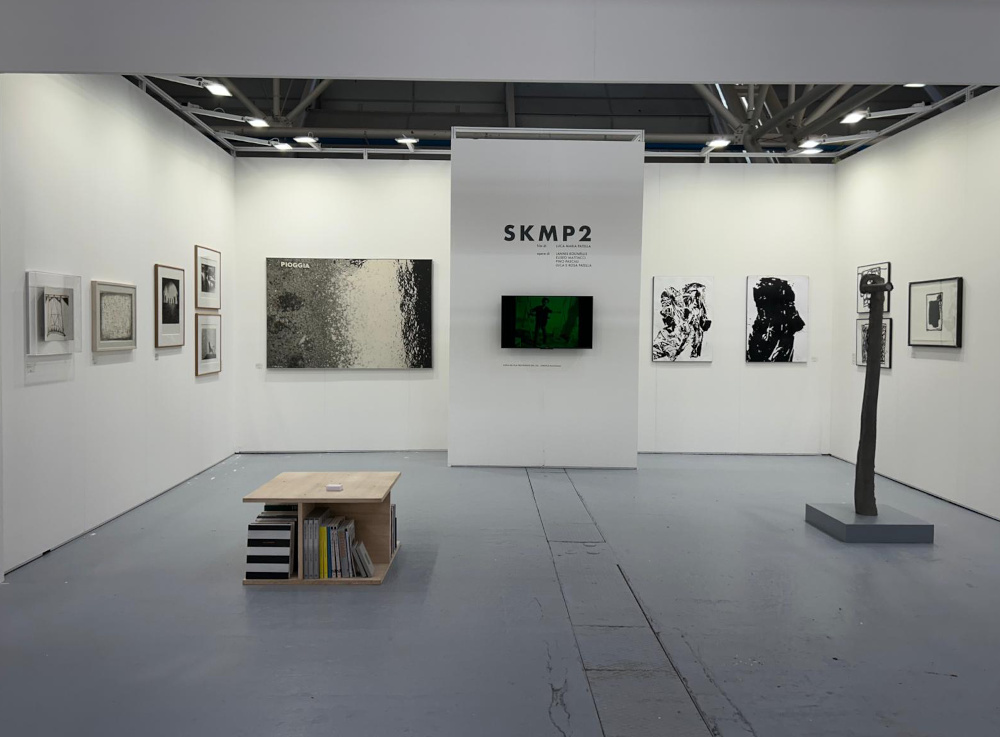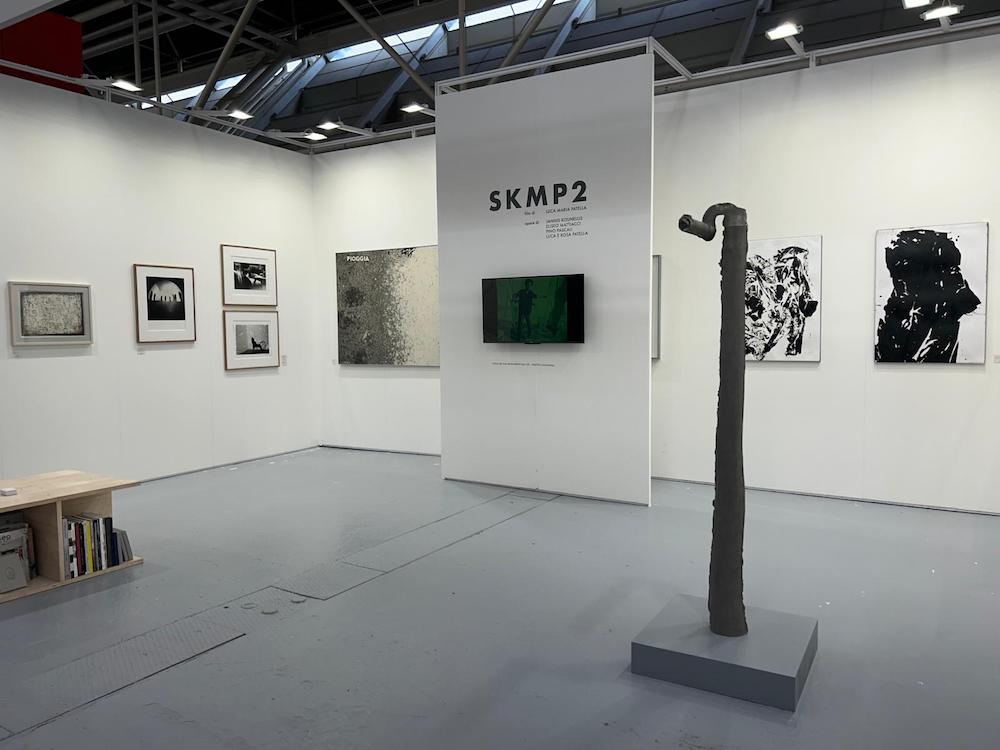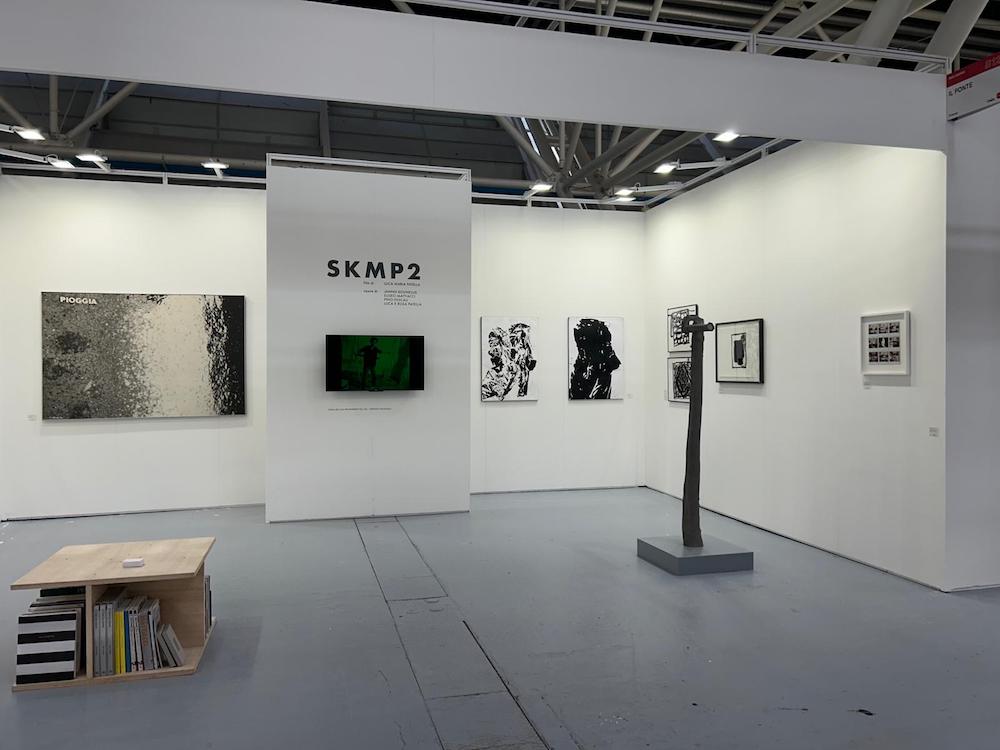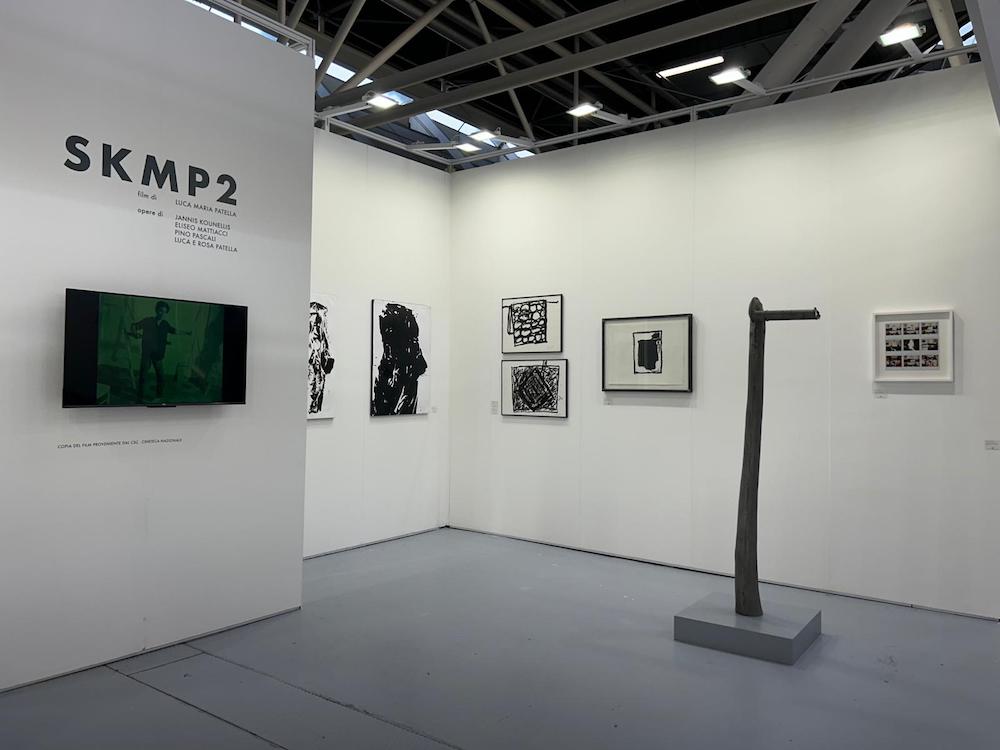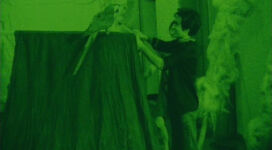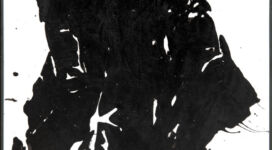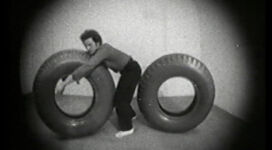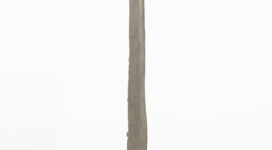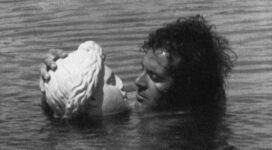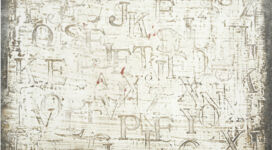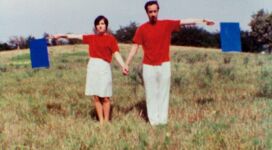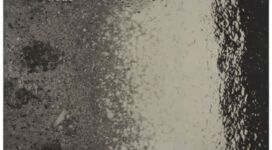| ARTEFIERA 2024 | ||
| Pav. 26 – Booth B 12 | ||
| 2 – 4 february 2023 | ||
| SKMP2. Copy of the video from the CSC-Cineteca Nazionale |
Gallery Il Ponte’s project for ArteFiera 2024, entitled SKMP2 – Sargentini, Kounellis, Mattiacci, Pascali, Patella, sees the screening of the film of the same name as well as the presentation of a selection of works by the artists involved in the film-project by Luca Maria Patella.
SKMP2 SKMP2 sounds like a chemical formula, which is just as Luca Maria Patella intended it, but it is also the inch-perfect acronym of the names of the five protagonists of a film that has since gone down in history, or the history of art at least: Sargentini, Kounellis, Mattiacci, Pascali and Patella.
SKMP2 is an artist’s film, but also a film about artists recorded during self-contained actions, performances, spontaneous creations and mise-en-scènes of their ephemeral works. Shot by Patella in 16 mm between April and late July 1968, and divided into four main episodes, the film was screened for the first time in public on 21 December of that year, on what was a very much emblematic occasion, as Fabio Sargentini’s L’Attico gallery took up residence in the garage in Via Beccaria and abandoned the elegant space in Piazza di Spagna. L’Attico was no stranger to film screenings. One such occasion was the group exhibition Fuoco Immagine Acqua Terra in June 1967, when Schifano had gone so far as to “display” two. But it was above all at Patella’s solo exhibition, entitled Ambiente proiettivo animato, on 30 April 1968, that slides, sound, projections and real behaviour had become fundamental parts of the work.
SKMP2 was thus part of the brilliant, red-hot climate of creative experimentation of Patella’s conceptual research (which had been producing “film-works” in 16 or 35 mm, including the famous Terra Animata, since 1967), L’Attico’s disruptive activity, and the work of innovative artists such as Mattiacci, Kounellis and Pascali. SKMP2 is a generational film which put all the participants, from director/operator/editor/sound-maker Patella, to producer/situation-stimulator Sargentini, to the actors/creators/protagonists, in the same demographic boat, from the youngest Mattiacci (b. 1940) to the “oldest” Patella (b. 1934). But SKMP2 is also a document of a group of avant-garde artists who all work for the same gallery. It is a spontaneous work in which each one acted freely and in his own way. Limited in time and space, it chronicles a very precise situation that is not staged, nor to show who’s who, nor ideologically driven but rounded and intensely alive.
SKMP2 is made up of four main episodes, each one dedicated to a single artist. Each episode can then be divided into a chapter or sub-episode, however you wish to call it, at will. The locations where the artists found themselves being filmed were respectively: for Kounellis, his studio-home in Via del Banco di Santo Spirito in Rome; for Mattiacci, L’Attico in Piazza di Spagna, the studio and the street in Via Nomentana; for Pascali, the beach of Villaggio dei Pescatori in Fregene; and, for Patella, the Tuscan countryside and the EUR neighbourhood in Rome. The film’s opening credits read: “SKMP2 Kounellis Mattiacci Pascali Patella – Ironic visual reportage by Patella”. The film’s prologue contains both a pinch of irony and erudition. Like in Clair’s Entr’acte from 1924, with the roar of an engine in the background, Sargentini uses a magic wand to make some of the main “actors” in the film appear and disappear.
The first episode is dedicated to Mattiacci and is shot largely with a fish eye lens, one of several technical tricks that Patella liked to use directly on camera (including fades, pixilation, staccato and stop motion) and that give the film its originality. Divided into three sub-episodes (the first and last of which were filmed in L’Attico), it captures Mattiacci playing with large lorry tyres which thanks to the stop motion effect seem to dance to the notes of Saint-Saëns and Bach (who will also accompany the other episodes). Then, after riding them as if they were a motorcycle (to use the artist’s words: in the “dynamics of the object itself”) or going around the city inside his Praticabili, corrugated galvanized sheet metal sculptures, at the end of the third chapter he falls to the floor of the gallery, knocked over and killed by his fun-filled tyres.
The second episode stars Kounellis. Also shot with the fisheye and with background music from Saint-Saëns’ Carnival of the Animals, it opens with images of poles clothed in wool, a parrot, bird cages, piles of charcoal on the floor, a toy train that suddenly breaks to a window view of a real train in motion. Next is the central chapter “Area Verde” (in the same green tone as the title), documenting Kounellis and Sargentini taking to a vat a large cloth, which is then dyed in a bathtub and hung out in the room with the help of Anna Paparatti and Efi Kounellis.
The third episode is entitled Manovre Naturali. In it, Patella, who describes himself here as “proto-conceptual and future”, and his partner Rosa Foschi, command the movements of the clouds with flags (in homage to the semiologist Prieto) and fantastically glide over meadows (the couple, completely alone, “come to life” thanks to a 10-metre-long cable manoeuvred and concealed in the same Patella’s hands). The episode is divided into three chapters, punctuated by words such as “No, another behaviour”. It is in colour, in a blue or a black-and-white tone, with typical “autopedone” (blocked walking) effects, a series of shots of a watch, an exposure meter, four profiles of Patella’s face, the sound of a speech in reverse, hammering nails into a wall, hanging a small engraving on it and drinking a glass of water.
The last episode is entitled simply Pino. Pascali, who died on 11 September 1968, did not have time to see the final cut, although Patella recalled that he had been able to view some clips with him. Patella threw away none of them and did not cut anything, in memory of his late friend. The episode likewise features famous fisheye shots of Pascali’s works from the solo exhibition at the Venice Biennale (his last exhibition, still underway at the time) and of the “fertility ritual” performed by the artist on the beach at Fregene (interesting titbit: the group were accompanied on set by Pistoletto in his van, with his partner Maria Pioppi). Broken up by numbers into five sequences of an initiatory ceremony (from Pascali’s emergence from the sand to cutting the water with scissors and planting baguettes…), toned partly in gold, the episode is the last and extreme testimony of a behavioural work, a true performance in the sense of the ritualistic Living Theatre sets that Pascali so admired. Impossible to classify as simply an artist’s film, it is the creative documentation of various performances or works.
SKMP2 is a collective work produced by Sargentini (sparker of artistic genius). Cultured directorship (drawing from Buster Keaton to Georges Méliès) and Patella’s direct, daring use of film technology and know-how brought avant-garde aesthetic possibilities to life in an intense and disruptive, never-to-be-repeated moment of history and creative circumstances (embodied in the works of Kounellis, Mattiacci, Pascali and Patella himself).
